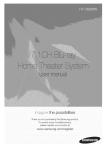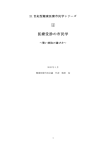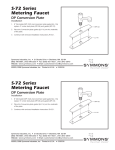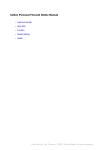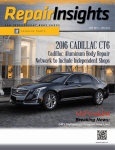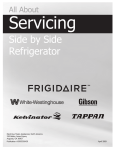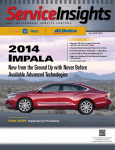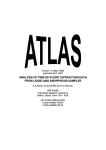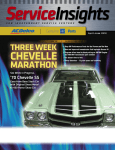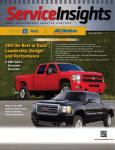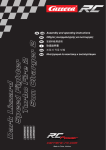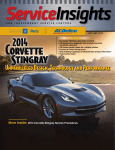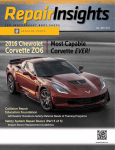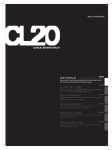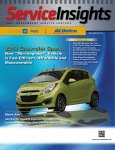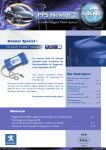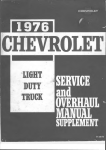Download 2015CHEVY CITY Express Van
Transcript
ServiceInsights FO R IN DEPE N D E N T SE RV I C E C E NTE R S JAN–MAR 2015 2015 CHEVY CITY Express Van IN THIS ISSUE Introducing the LT1 crate engine Curtain call for the COPO Camaro D rag Racer Massel Lands a COPO Camaro, and then a Title C hevrolet Performance in a Smaller Package More Inside: Service Procedure for 2015 Chevy City Express Van 2015 Chevy City Express Combines Fuel Efficiency with Cargo Hauling Performance Re-Investing Rewards: Nebraska ISC Taps Genuine GM Rewards to Improve Customer Experience gmserviceinsights.com GMSERVICEIN Contents 4 / Introducing the Most Advanced Chevy Small Block Ever, the LT1 Crate Engine GM ServiceInsights Online More Genuine GM Parts resources and links. 4 Download this issue and past issues of GM ServiceInsights magazine at... 5 / Curtain Call for the COPO 5 www.gmserviceinsights.com GM ServiceInsights Headquarters 2604 N.E. Industrial Dr., #230 N. Kansas City, MO 64117 Email: [email protected] 6 / Drag Racer Massel Lands a COPO Camaro, and then a Title We Support Voluntary Certification National Institute for AUTOMOTIVE SERVICE EXCELLENCE www.ase.com 6 Compliments of your GM dealer. We invite your input and suggestions. Please address letters to the editor to the above address. Letters submitted imply the right to edit and publish. Every effort is made to ensure the accuracy of the information in the offers contained in this magazine. However, printing and typographical errors may occur. These are not intentional and are not the responsibility of GM, any dealer or the companies or individuals who create, produce and distribute this magazine. Offers and pricing may change at any time without prior notification. The descriptions and specifications in this publication were in effect at the time of approval for printing. General Motors reserves the right to change specifications without notice and without obligation. Published letters do not necessarily reflect the opinions of General Motors or General Motors Parts. General Motors, Detroit, MI 48202. © 2015 General Motors • All rights reserved. 7 / Radiator Assemblies Join Genuine GM Rewards Program 7 8 / Chevrolet Performance in a Smaller Package: 4-Cylinder LTG 8 Turbocharged 2.0L Joins the 2015 Crate Engine Lineup 10 / 2015 Chevy City Express Combines Fuel Efficiency with Cargo Hauling Performance 10 13 / 2015 Chevy City Express Repair Procedure TechTips The following service repair, technical tips the Diagno provide repair speak with stic Hotline information a technica about specific l expert with can conditions the latest help. Call 1-800on a OEM informat 825-58 86, prompvariety of vehicles ion. . If you have t #2, from a tough 8 a.m. to or unusual 8 p.m. ET Chevrolet Monday–Friday, The Driver Captiva 14 Informa to messag tion Center es Full Continu“Diesel Partic Filter Is Cadillac Partic Filter e Driving” and “Diesel ATS, XTS; : 2010-2015 SRX; To prevent aIssteering Full Mandat 2013-20 2014-20 gear squeak ory” may Continu ed Driving 2015 Cadillac Buick noise on 2008-2012 15 15 CTS Enclave, vehicles 2009-2012 be displaye Sedan, ELR; Chevrolet Escalad equippe Acadia, and d onTraverse, 2007-2012 GM e Models 2007-2010 d with engine (RPO Saturn the Outlook July 1, 2011, diesel models, built Chevro LUZ). prior tolet: 2010-20 recommends Particulate GM Equinox DTC P2463 that the power steering 15 Camaro changed ; 2011-20 Filter Soot ®-VI fluid , also mayto DEXRON be automatic(Diesel 15 Cruze, Accumu transmission 2012-20 steering 15aSonic; gear be assembly fluid when Volt; set. When lation) is replaced sets, the Spark; 2013-20 for 2014 ECM comma DTC P2463 any reason. 15 The original control BEV; 2014-20Silverado 1500, Malibu, nds cause ofsystem Spark the 15 Caprice to operate the engine Engine Impala, PPV, Corvett SS; squeak Power. in Reduce suspen noise Suburban, 2015 Colorad The fastener must sion d e, may o, Silverad travel. Thebemessag due Tahoe Diesel Front Strut Noise already be tightened This Particulate Filter o, INParticul THIS ISSUEes indicate to insufficient to conditio GMC: 2010-20 the specified that a Diesel n 2008-2014 Chevrolet Captiva Sport; initialMessage Filter (DPF) grease ate regener in the 15 Terrain; 1500; 2015 maytorque cleaning beforeGMC be ation, 2010-2014 Chevrolet Equinox, applying the angle due Chevrolet Cruze equipped 2014-2015 2014 Sierra pinion Canyon, shaft. . . . is engine Front Strut Noise . . . required . . . . . . . . . . . . . . . . 15 , or Models to the Sierra, specification. Terrain; and 2008-2010 Saturn VUE , based run time, withinside the 2.0L Clean Turbo Diesel Yukon seal. The on pinion distanc diamete Engine e traveled fuel consumed r Bottom shaft seal The Global A popThe desired of portion angle value cleaning since .the Diesel Particulateto Filter Message . . . . . . . . 15 and A electric of the strut front . pinion shaft ated with ping or clunk can be set from the The last DPF Center al system 0–199 Driver Informationshaft. strut jounce “Diesel Partic Filter Is noise cominterface and associdegrees. controller these vehicles messages The DPFFastener does not bumper system Understanding Tightening ing from the lack Full rubbing Continue Driving” and “Diesel out of lubricaSwapping swaps between allow filters of the When readyoftothe Specifications . . . . . . . . . . . . . . . . . . . .soot . . . . . . particle 16 vehicles front of the measure Partic Isagainst Full Continued Driving tion may exhaus strut,Filter ECM the piston gen- t gases. includin ECMs or other . s angle using the creating displayed determ g Radio, When modules, vehicle may tion. Mandatory” J-45059-A erate ines that a slip-stic on rod a noise. To of soot Body Control (BCM), correct may be Angle Meter,grease a . . . . . . . . . 17the k condibe heard has collecte Electron this conditio apply avehicles with the diesel Using Angle Meter . . . . . . . . . .specific Thisannoise slight equipped Module ic Brake look to (EBCM), force in the requiredengine the(RPO n, apply for all oforigi- d in the DPF,amount during small top and LUZ). DTC P2463 (Diesel Control nates Sensing strut direcin thethe conditio J-45059-A bottom it will Module be met tion of rotation to shaft. (SDM), Angle to medium Meter Particulate Filter Soot Accumulation) of the intheorder eliminate gear but Transm Diagnostic that must Changing Powerto Steering Fluidns may free-play in the With tion. (TCM), Electronission Control Module suspension initiate to also may be set. When DTC P2463 This like socket, sound theextension, self-cle DEXRON-VI Fluid . . . . . . . . . . . . . . .a. . regener . . . . . . 17 it. is vehicle Module and the bolt at this travel. This driver. Do ic Climate aning function automa the ECMraised commands the not engine (HVAC), lift-type atime. sets, turn coming tically hoist, system from Electron on a in Control when condition runs frame control pull operate Reduced metthe ic Power (ECC) (EPS), Hybrid jounce bumper thetodust andsteering With free-play hose at the power conditio may take theInlet Steering shield/ may be due Engine Power. ns are steering fluid reservoirPowertrain press assemb without Module struteliminated, up to 25 thelyStart button, the meter will column top mount anyarea. Control (HPCM), display to the inside out of the and minutes notifica WAIT, followed The cup andindicate Panel Cluster BottomTURN portionisofdisplayed, theto strut and the The messages thatWhen a Diesel The by TURN. expose DPFsteering to the driver., diameter geartion slide is cleaned Instrum assembly the the meter it down (IPC), topisportion zeroed. Particulate Filter (DPF) cleaning, or ent burning not be replaced untilshaft. squeak noise cles with shaft.angle Turn the desired by periodicshould of the front driver condition. for the Apply off the soot this Global between two of thethe is grease, For the reached. While allysqueak noise, regeneration, is required, based turned, a yellow strutison gear housing temper vehithe meter will (in Canada strut jounce particle only GM result the steering bar isengine ature. Fuelshould be replaced P/Nconsumed s at high in damagi A electrical system ,displayed run time, fuel and 109534 that gets 123455 and the power thethe tem should setpiston higher longer and bumper rubbing against rod angle circumf consum steering as 81), be 79 is neared. ng refilled cause sysduring around with Withintraveled erence ption DEXRON-VI. distance since the last DPF 5–10 degrees no start both controllers offers the this may be Theconcern the of the strut, creating aangle, slip-stick of the the condiof the set DEXRON-VIa fluid self-clecorrection end permanent expose of the conditio cleaning. aning period. d. yellow bar strut red, . Under certain for the squeak noise. meter willapply n or other tion. To correct this condition, and thatthe beep and flash when will turnshaft In additiondriving is to the squeak anglefilters Unseat grease to the top and bottom of the DPFthe system soot particles such tion is reached. as short conditionoise correction, The no start theThe The J-45059-A Angle to convert distanc ns, bottom recommendaconditio the onthe from strut shaft. power out of the exhaust gases. When the driving or www.acdelcotechconnect.com, Meter es, both of can n will occur stop steering bethe fluid to DEXRON-VI handle when thethe strut vehicles for extende used on dust and replacements ashield ratchet and may not gear ECM that a specific amount d Newsletters are swappefluid is if these portionfastener click the linkand go idling, only is determines in expose an area with not for repairs With the vehicle raised on To a frame access. components, be able of the modules the system limited the inbottom to other system use d due to such as the of soot collected the DPF, it willmatical struthas grease pump, cooler or security shaft. lift-type hoist, pull the dust shield/ the new this ly, eventuato clean itself feature, around hoses. code lookthe for all of theApply conditions autothe that mustInforma A tag identifying lly causing implemented protocol (environvehicle strut jounce bumper assembly out of the circumference after the that the tion Center meter shaft that be met in order to initiate a regenera-displaye thevehicle DEXRON-VI ment) Driverhas been converted towith the is expose strut top mount cupisand slide it down of the should Global messag be installed zeroed, 2010 Diagnos d. If and tion. This self-cleaning function runs d. es to beon the power steering filler theand neck to expose the top portion of theSlide strut the dust tic System model year DPFsecured as cations. reservoir the ratchet is not with the cap. automatically is shield/jo when the conditions are required, the “Engine (GDS) applicleaned shaft. Apply grease,being GM P/N assemb 12345579 ly down If the power steering turned, metand and may unce take up to 25 minutes,Reduced” Power tom (in Canada, 10953481), theto the system messag reattach bumper Is on these vehicles has original stoparound turning without any notification to the driver.this occurs, fluid, ethe will the botsystem the display. circumference of the strut shaft is strut. Push dustthat should self cleaning be flushedProd shield/jo DEXRON-VI. When momentarily. The DPF isthe cleaned by periodically is no longer and refilled uctwith top of Due to of unce exposed. the Infor Scan the code between to the interface Follow ACDelco up into the bumper possible and the The ratchet DPF off theassemb soot particles at high the the topburning fluid, it and be necess Forpinion is critical shaft seal mation free technical download a PDF to ensure mount cup Fuel service possible ly ary. Unseat the bottom the dust shield that contact canofbe temperature. consumption may be informati no Refer old with assistanc will turned fluid Service the by comes as on to new seal. Be sure to in regarding the appropr e as Informa from the strut and back, expose the bottom hand. Theduring fully productsflush thisfar self-cleaning period. fluid thoroughly fromtion but specific and product assemb the for the seat once higher system follow the iate , contact all old ACDelco ly will to installing DTC prior portion of the strutdisplayed shaft. Apply the the vehicle these toll-free ground assembly diagnos thehotlines P2463 new steering ortic angle and the Under staffed by housing. certain driving conditions, and gear is on informati procedu grease around thewill circumference of the ASE-cert the stop and go suspen not to The J-45059-A compre re. change. such as sion short distances, ified technicia on When changing Angleis Do Meter ss. with strut shaft that is exposed. can allowed the fluid, raise used At the end of ns: Brakes drive extensions driving or extended idling,bethe system Not Swap Using an Front Angle Noise Meter 2008-20Strut 14 2010-20 An angle meter, such as theChevro let Equinox Sport; Angle Meter, is Terrain; and J-45059 , GMC 2008-20or J-45059-A used to ensure 10 Saturn when tightening A pop-with proper fastener tightness fasteners a Torque Plus AngleVUE and Torque Plus ping (TA) Angle or Yield (TAY) angle meters are noise to clunk specification. designed comfor use with standard These or 1/2-inch squareing 3/8-inch drive extensions, ratchets, or breaker the bar handles, or for from front useof with a 1/2-inch square the drive vehicle “click” style torque may wrench, approximately 1 be heard inch to 1-1/4 inches (25 during small to 31 mm) to medium in diameter. Changing the Power Steering Fluid to DEXRON-VI Fluid the vehicle until– 1-888-70 are approximately and ratchets. the wheels Contr Modules 24 inches off the the back-swing, 1-6169 (prompt Slide the dust shield/jounce bumper may not be able to clean itself autoDiese Chassis ground. power steering fluid ol Disconnect l Partic and ReadySt #1) the reservoir stop assembly down and reattach the botmatically, eventually causing the Driver steering momentarily ulate again, and ruts – 1-800-27 Mess The followin fluid reservoir and inlet hose from the power Clutches the meter Filter tom to the strut. Push the top the increase age Information Center messagestoto be will continue plug the power steering – 1-888-72 the of 0-2124 angle g GM ervoir inlet Global Archite port. models 5-8625 from this With the key ON dust shield/jounce bumper2014-20 assembly measured displayed. If the DPF is not cleaned ratcheted Supportsfluid respoint. and theLift cture wheel use the steering the Thecup engine J-45059-A – 1-800-79 15 Chevro up into the top mount as far asAngle turn fully as required, the “Engine Powersystem Is : assistant (Global to the left and toShocks OFF, Meter with A) electric 0-5438 letrequires the a AA battery. the right Cruze maintains the – 1-877-46 2.0L possible by hand.The TheJ-45059 assembly will while an Angle al fluid Reduced” message will display. When Meter equippe minimum Clean uses Engine 6-7752 two #CR-2032 Buick: 2010-20 using DEXRON-VI Tovehicle level in the reservoir Turbo d of the DPF replace fully seat once the isthe on the batteries. this occurs, self cleaning batteries, separate Diesel fluid. Continue until Starters and Alternato 15 2011-20 the front the fluid from the back. is allowed LaCross case fluid ground and the suspension reservoir from is no longer possible and service will 15steering rs (New) the power e; inlet hose runs – 2013-20 toRegal; red. This may require three 2012-20 to compress. – Thanks to 15ofVerano; DEXRON-VI fluid.Starters and up 1-800-85 Tedd Magana be necessary. Refer to the appropriate 15 Encorequarts (3 L) 4-0076 Alternato Service Information for DTC P2463 and – Thanks to Peter rs (Reman) Robert follow the diagnostic procedure. – Steering 1-800-22 – 1-855-45 8-9672 1-1212 Wiper Blades – 1-800-81 0-7096 13 15 / TechConnect Insert 15 TechConnect is a magazine to help professional technicians improve their knowledge and understanding of today’s increasingly complex vehicles. 18 / Re-Investing Rewards: Nebraska ISC Taps Genuine GM Rewards to Improve Customer Experience 18 2 Jan – Mar 2015 ServiceInsights NSIGHTS.COM 3X Easier THE OE POWERTRAIN CALL CENTER 1-866-OE-PARTS (1-866-637-2787) General Motors, Ford and Chrysler have come together to support independent installers with the convenience of one stop shopping: ✔✔ Tech support ✔✔ Purchase ✔✔ Parts info GenuineGMParts.com genuinegmparts.com Jan – Mar 2015 ServiceInsights 3 GMSERVICEIN A New V8 Standard LT1 Crate Engine Introduction is the Most Advanced Small Block in 60 Years Chevrolet Performance owes its sustained success to the skills of master engine designers and builders plying their craft. Advanced and groundbreaking as they consistently are, new engines bearing the Chevrolet Performance name always layer new technology on a solid base of tested, proven and timeless engineering. And so it is with the newest exciting and groundbreaking addition to the family: the Gen V LT1 crate engine. Working off of the LS family of small-block engines, GM engineers leveraged some of the latest high-performance technologies to create what is easily the most advanced Chevrolet Performance V8 crate engine ever offered. The enhancements amount to the most extensive and significant redesign in the 60-year-history of the Chevrolet small-block V8. 4 Jan – Mar 2015 ServiceInsights The engine, available with both a wet-sump oiling system (Part #19328728) and a dry-sump system (Part # 19329997), is modeled after the production LT1 6.2L that made its first appearance in the 2014 Corvette Stingray, but comes with accessories that make it a snap to install in all types of project vehicles. Engineers left few areas untouched when they set out to establish a higher power and performance bar for the small-block V8. Features as far ranging as direct injection, continuously variable valve timing, an advanced combustion system, camshaft phasing, a high-pressure fuel pump, and a refined and modified engine block contribute to an engine that produces 460 hp at 6000 rpm and 465 lb.-ft. of peak torque at 4600 rpm. Jim Campbell, U.S. vice president of Performance Vehicles & Motorsports for GM, calls the new LT1 an impressive achievement that builds on past proven success. “We’ve added new technologies to improve power and efficiency, but that basic small-block V8 architecture has been a constant since the beginning,” he says. In designing the new crate engine, Chevrolet Performance engineers went the extra mile to make installing the LT1 as simple as possible, regardless of the application. “In addition to the crate engine itself, coil covers with Corvette branding, rocker cover insulators, a new engine control system and a front-end accessory drive system will be sold separately,” says David MacWebb, product specialist, Chevrolet Performance Parts. “What you put in it will dictate what you’re going to buy. It will be basically a plug-and-play package.” Other accessories include an LS/LT manual bell housing; LS/LT dual disc clutch; an aluminum automatic bell housing; an oil hose adapter; and an LT-series starter. The LT1 can be paired with a range of automatic and manual transmissions, including Chevrolet Performance’s newly released T56 Super Magnum 6-speed manual transmission. The LT1 and the T56 can be purchased as a Connect & Cruise package, an offering that pairs engines, transmissions and other retro-fit components in a time- and price-saving bundle. The LT1 is also available in other Connect & Cruise configurations with 4L60-Series automatic transmissions. NSIGHTS.COM All the stories in Service Insights, additional content and pictures available at gmserviceinsights.com GMSERVICEINSIGHTS. CURTAIN CALL FOR THE COPO Drag Track Star Camaro to End its Second Run in 2015 As the curtain on the fifthgeneration Chevrolet Camaro drops, so ends, too, the modern-day run of the legendary COPO Camaro. Once again, only 69 of the drag strip-only vehicles will be built in 2015, continuing the trend of honoring the year 1969 when the first COPO Camaros were specially built to highperformance specifications for select dealers and their customers. But barring any decision down the road to bring the COPO back for a third encore, the 69 that will be built this year will be the last. GM resurrected the COPO, an acronym for Central Office Production Order, as the specialorder Camaro program came to be known, in 2012. Only 69 were built that year and in each of the two thereafter. Just as interested buyers put their name on a list and hoped to be selected in a lottery in those years, they’ll do the same again in 2015, each eager to get a shot at securing a piece of automotive history. Some 3,500 people vied for a chance in 2014, and interest is expected to surge for this the finale year. Although each COPO is built on the same basic platform, options are available that allow for customization. Four LS-family Chevrolet Performance crate engines are available: naturally aspirated 427s, 396s and 350s, and a 350 with a 2.9L supercharger. Transmission choices are a THM 400 3-speed automatic and a 4-speed manual. Other aesthetic elements that can be customized include exterior color, wheelie bars, wheels and hoods. The flagship 2015 COPO, on display at the Specialty Equipment Manufacturers Association (SEMA) show last fall, had an Abalone White exterior with gray and orange accents and all-new COPO graphics. It was powered by the 350 engine with the 2.9L Whipple supercharger. Buyers, who include enthusiasts buying them for the investment value and racers wanting them for the stock eliminator circuit, also are rewarded with the rare opportunity to see some of the build process. Prior to picking them up at the COPO Build Center in Oxford, Mich., buyers have the chance to watch the final touches being put on their cars. “It takes just over two weeks to build a COPO,” says Curt Collins, manager, Chevrolet Performance and Licensed Parts. For more photos and to read the rest of the story on the COPO, go to gmserviceinsights.com. Jan – Mar 2015 ServiceInsights 5 GMSERVICEIN GM OE Parts Update Drag Racer Massel, Lands a COPO Camaro, and Then a Title “Better late than never.” That’s not something you’re likely to hear come out of the mouths of many competitive race car drivers with a consuming hunger to cross the finish line first. But you just might hear it from Bruno Massel. The drag-strip star passed up opportunities for a chance to buy a second-generation COPO Camaro the first two years it was offered. When 2014 rolled around, he decided to put his name in the hat. As luck would have it, he was one of only 69 lottery winners who got the first crack at buying one of the 69 COPO Camaros in that year’s production run. But that was just the beginning of Massel’s good fortune. He not only got the first Supercharged COPO of 2014, but he coaxed it to a groundbreaking win in September. On top of that, he’s now the proud owner of a legendary car that might never be made again. With the COPO program ending this year, Massel owns one of fewer than 300 that will have been made in the four-year run of the COPO Camaro program’s second installment that began in 2011. With his customized COPO, powered by the supercharged 350 engine option he selected, Massel took the top prize at the Chevrolet Performance U.S. Nationals in September. He beat another COPO in the Stock Eliminator final, claiming the first overall win ever for a COPO in an NHRA National event. The win was proof, Massel says, that his instincts about the COPO were right, if a little late in coming. He had known about the COPO since its reintroduction, but it wasn’t until he saw one up close at the end of the 2013 season that he got seriously interested in pursuing one. Its unique qualities – raw, track-ready power dressed up in alluring “street” clothes – added up to something he couldn’t afford to pass up. For more photos and to read the rest of the story on Bruno Massel, go to gmserviceinsights.com. NSIGHTS.COM Radiator Assemblies Join Genuine GM Rewards Powertrain Program Purchases of GM OE radiator assemblies are now eligible for rebates under the Genuine GM Rewards Powertrain program. As of January 1, 2015, Genuine GM Rewards participants will receive redeemable points equivalent to two percent of list price with the purchase of Genuine GM Parts radiator assemblies from their participating GM dealer. Points accumulated under the Rewards program are automatically credited to a customer’s account, easily set up through a participating Genuine GM Parts dealer. The points can be redeemed at any time for a broad mix of goods and services that can be viewed via the online portal, www.GenuineGMRewards.com. Now more competitively priced In addition to joining the extensive roster of Genuine GM Parts eligible for the Rewards program, radiator assemblies are now more competitively priced. In sharp contrast to aftermarket, non-OE assemblies, Genuine GM Parts assemblies are assured of being the right match for the vehicle, install quickly because of that match, and perform in line with manufacturer specifications. The OE assemblies consist of all new, not repaired or remanufactured components typical of non-OE products. That distinction comes into play with variables like fin counts and tube sizes, both of which affect a unit’s cooling capacity. Non-OE assemblies can come with reduced fin counts and improper tube sizing, jeopardizing maximum performance. Now, with a 2 percent rebate on top of more competitive pricing, there are a lot of good reasons to look to Genuine GM Parts for a replacement radiator assembly. PRODUCT REWARD Engine and Transmission Assemblies* 50 Points Each Transfer Cases 25 Points Each Powertrain Component Parts** 4% Dealer List Radiator Assemblies Added in 2015 2% Dealer List *Excludes Chevrolet Performance Engine and Transmission assemblies. **Excludes hybrid batteries and parts on national control. Each Reward Point = $1 ✔ ✔ ✔ ✔ asy turnkey process (no paperwork) E 24/ 7 online account access Rewards never expire Redeem rewards on your own terms Jan – Mar 2015 ServiceInsights 7 GMSERVICEIN GM OE Parts Update (cont’d.) Chevrolet Performance in a Smaller Package 4-Cylinder LTG Turbocharged 2.0L Joins the 2015 Crate Engine Lineup A four-cylinder that’s as powerful as it is compact and lightweight joins the Chevrolet Performance crate engine lineup in early 2015. It’s the all-new LTG 2.0L turbocharged Gen III Ecotec engine, inspired by the production engine that made its debut in the 2013 Cadillac ATS and Chevrolet Malibu. It joins a generation of more efficient GM large-displacement four-cylinders. This 272-hp, dual-overhead cam engine opens up a whole new route to V8-like power for enthusiasts facing dimension and weight challenges in their performance car-build projects. Lighter than a similarly powerful V8 due to its all-aluminum construction, the LTG can improve a vehicle’s front-to-rear weight balance, enhancing performance. While it may be smaller and lighter than typical 8 Jan – Mar 2015 ServiceInsights performance engine options, the LTG doesn’t back down in the power or efficiency departments. The power specs – 272 rated hp at 5500 rpm and 295 lb-ft of torque at 3000 rpm (90 percent of peak delivered between 1700 rpm and 5500 rpm) – are further enhanced with a twin-scroll turbocharger. This advanced design generates the kind of throttle response normally seen in larger, naturally aspirated engines. It is capable of generating a maximum boost of about 20 psi, enabling the maintenance of peak torque between 3000 and 4600 rpm. Another LTG feature, direct fuel injection, enhances the turbocharger’s output and efficiency. It allows it to operate at a higher boost and higher compression than would be possible in a conventional supercharger. The engine, sold under part # 19328837, is designed for use with a rear-wheel drive transmission. It is sold alone, as well as part of a package that can include a 6-speed manual transmission (#19328976); clutch kit NSIGHTS.COM (#24251131); LTG alternator (#19329020); and an LTG engine controller (#19328839). Like all Chevrolet Performance crate engines, the LTG carries a 2-year/50,000-mile warranty. Other key features that make the LTG a good fit for build jobs where a mixture of weight and dimension restrictions have to balance with the demand for power and performance and the desire for economy. ˩˩ DOHC with continuously variable valve timing. Overhead cams and a four-valve-per-cylinder design is integrated into the lightweight aluminum cylinder head. Variable timing produces improved turbo response and greater torque delivery. Intake and exhaust cams have vane-type phasers that changes valve timing in response to rpm and engine load. The end result is smooth torque delivery over a broad rpm range, high specific output and good specific fuel consumption. ˩˩ Cam-driven high-pressure fuel pump. Direct injection requires this engine-mounted pump, which is augmented by a conventional fuel pump in the tank. The fuel delivery system consists of a high-pressure stainless steel feed line and pressureregulated fuel rail. Pressure at idle is 750 psi; 2,250 psi at full throttle. ˩˩ Air-to-air intercooler. This intake charge design helps maximize the benefits of the turbocharger by reducing the temperature of the compressed air forced through the intake system by the turbocharger. The result is cooler air, with a higher density that means more oxygen is packed into the cylinders. That translates to greater power. ˩˩ A refined engine block. The sand-cast block builds on previous Ecotec castings. With stronger main bearing bulkheads that support higher loads and an improved oil distribution system enabling better flow and heat dissipation, also the LTG’s noise/vibration/harshness levels are lower. ˩˩ A two-stage, variable displacement oil pump. This crankshaft-driven pump changes its capacity based on the engine’s oil demands, improving efficiency, maintaining optimum oil temperatures and allowing for faster oil heating during cold starts. With the LTG, Chevrolet Performance has again broken new ground, proving that its definition of power and performance isn’t constrained by its historic focus on big V6 and V8 engines. This newest entry will thrill enthusiasts who want to explore new frontiers in performance without sacrificing the qualities they expect in a Chevrolet Performance crate engine. Jan – Mar 2015 ServiceInsights 9 GMSERVICEIN The Technical Side 2015 CHEVY CITY Combines Fuel Efficiency With Cargo Hauling Performance Chevrolet’s all-new, 2015 City Express matches maneuverability and cargo-hauling flexibility with efficiency, giving urban commercial business owners and fleet managers value-driven capability with lower operating costs than full-size vans. 10 Jan – Mar 2015 ServiceInsights It offers 122.7 cubic feet (3,474 liters) of customizable cargo space, a tight turning diameter of only 36.7 feet (11.2 meters) and a payload capacity of 1,500 pounds (680 kg). It will also deliver greater efficiency than full-size vans, thanks to its smaller size and a 2.0L inline-four-cylinder engine with continuously variable valve timing. “As the newest member of the Chevrolet Express family of vans, the 2015 City Express offers a smaller, more-efficient choice for businesses that don’t need the NSIGHTS.COM cargo volume or other capabilities of a full-size van,” said Ed Peper, U.S. vice president for GM Fleet and Commercial. “It is an easy-to-maneuver van that makes the most of its compact dimensions with clever features, allowing business owners to maximize its space — and their resources — with a vehicle sized just right for their needs.” Under the hood and more The City Express’s DOHC 2.0L inline-four engine with continuously variable valve timing is rated at 131 horsepower (98 kW) and 139 lb-ft of torque (188 Nm). It drives the front wheels via a continuously variable transmission that contributes to efficiency by optimizing torque delivery across the rpm band. A body-integral chassis is designed to provide a balance of strength and low mass that enhances efficiency and the feeling of performance. A MacPherson-strut suspension is located in the front and there’s a truck-style multi-leaf rear suspension. Other chassis features include 15-inch wheels, front disc brakes and efficiency-enhancing electric power steering. Four-wheel anti-lock brakes and electronic brake-force distribution are standard, as is an electronic stability control system. The City Express also comes standard with six standard airbags: dual-stage frontal air bags, side-impact supplemental air bags and roof-mounted curtain air bags for side-impact and rollover protection. Chevrolet offers City Express with the best van coverage in America: ˩˩ Three-year/36,000-mile bumper-to-bumper warranty ˩˩ Five-year/100,000-mile powertrain warranty ˩˩ Chevrolet’s Complete Care two-year/24,000-mile scheduled maintenance. But the Chevy City Express Van is not the only option Continued on page 12. Jan – Mar 2015 ServiceInsights 11 GMSERVICEIN The Technical Side (cont’d.) Continued from page 11. for small businesses and fleets to consider. GM has several vehicle models that have CNG-powered versions. Chevrolet Express and GMC Savana use a proven, 6.0L Vortec V8 engine with factory-installed hardened exhaust valves and intake/exhaust valve seats. These components are engineered to GM durability standards for gaseous fuel use. The CNG fuel system is available on Cargo and Passenger full-size vans, in both regular and long wheelbases. Two systems are offered: ˩˩ (UFM) Three-tank system provides a range of up to 200 miles. Allows for full cargo capacity or seating for passenger vans. ˩˩ (UFP) Four-tank system provides a range of up to 300 miles. This system adds a single tank in the driver’s side of the cargo area, just inboard of the wheel well. Available only on Cargo vans. And they’re the industry’s only CNG vehicles that are fully integrated at the factory, crash tested and backed by GM’s 100,000 mile/5-year transferable Powertrain Limited Warranty. 12 Jan – Mar 2015 ServiceInsights NSIGHTS.COM 2015 Chevy City Express Repair Procedure Even though the 2015 Chevy City Express is a new vehicle, service and repair information resources are just a click away at www.gmtechinfo.com - Electronic Service Information. Technicians and shop owners can log onto the site to gain access to subscription services for service procedures and repair manuals. A complete Service Manual is accessible 24/7 through a subscription to the site. Free collision repair procedures will soon be available for the vehicles by going to www.genuinegmparts.com. Front Drive Axle Inner Shaft and Inner Shaft Housing Replacement 9 Removal Procedure 10 1 2 3 4 Drain the differential carrier assembly. Refer to Front Axle Lubricant Replacement. Remove the engine protection shield. Refer to Engine Protection Shield Replacement. 4 It is not necessary to remove the wheel drive shaft from the vehicle. 12 11 Installation Procedure 1 Install the new inner axle shaft bearing and the new seal to the inner axle shaft housing. Refer to Front Drive Axle Inner Shaft Seal and Inner Shaft Bearing Replacement. Note: Do not nick or cut the inner axle shaft oil seal. Do not remove the inner axle shaft at this time. Install a support jack underneath the differential carrier assembly. 8 Remove the upper inner shaft housing bushing bolt and nut. 10 Remove the inner axle shaft from the inner axle shaft housing. 5 Disconnect the inner axle shaft from the differential case side gear using the pry bar. 8 Remove the inner axle shaft and inner axle shaft housing from the vehicle. Remove the inner axle shaft seal and the bearing from the inner axle shaft housing. Refer to Front Drive Axle Inner Shaft Seal and Inner Shaft Bearing Replacement. Place a pry bar between the inner axle shaft flange and the inner axle shaft housing. 7 11 13 5 6 9 Remove the inner axle shaft housing bolts from the differential carrier assembly. Raise the vehicle. Refer to Lifting and Jacking the Vehicle. Disconnect the wheel drive shaft from the inner axle shaft. Refer to Wheel Drive Shaft Replacement. Remove the lower inner shaft housing bushing bolt and nut. 2 3 Install the inner axle shaft into the inner axle housing. 2 Do not install the inner axle shaft completely into the inner axle shaft housing at this time. Apply sealant GM P/N 1052942 (Canadian P/N 10953466) or equivalent to the inner axle housing to differential carrier sealing surface. Jan – Mar 2015 ServiceInsights 13 GMSERVICEIN The Technical Side (cont’d.) 4 5 6 7 8 9 SPECIAL INSERT Install the inner axle shaft housing with the inner axle shaft to the differential carrier assembly. Caution: Refer to Fastener Caution. 4 Install the inner axle shaft housing bolts and tighten to 48 Y (35 lb ft). Install the lower inner axle shaft housing bushing bolt and nut. Install the upper inner axle shaft housing bushing bolt and nut and tighten to 85 Y (63 lb ft). Remove the support jack. Install the inner axle shaft into the differential case side gear by doing the following: 1. C arefully guide the inner axle shaft through the inner axle housing until the retaining ring on the inner axle shaft contacts the differential case side gear. 5 2. I nstall the inner axle shaft into the differential case side gear by tapping the retaining ring into the retaining groove using a soft–faced mallet and until the retaining ring on the inner axle shaft is fully seated within the groove in the differential case side gear. 3. Pull back on the inner axle shaft to ensure that the inner axle shaft is properly retained in the differential case side gear. 10 11 12 Install the wheel drive shaft to the inner axle shaft. Refer to Wheel Drive Shaft Replacement. Fill the differential carrier assembly with axle lubricant. Use the proper fluid. Refer to Front Axle Lubricant Replacement. Lower the vehicle. 7 14 Jan – Mar 2015 ServiceInsights 6 NSIGHTS.COM Front Strut Noise 2008-2014 Chevrolet Captiva Sport; 2010-2014 Chevrolet Equinox, GMC Terrain; and 2008-2010 Saturn VUE A popping or clunk noise coming from the front of the vehicle may be heard during small to medium suspension travel. This condition may be due to the inside Bottom portion of the strut diameter shaft. of the front strut jounce bumper rubbing against the piston rod of the strut, creating a slip-stick condition. To correct this condition, apply grease to the top and bottom of the strut shaft. With the vehicle raised on a frame lift-type hoist, pull the dust shield/ jounce bumper assembly out of the strut top mount cup and slide it down to expose the top portion of the strut shaft. Apply grease, GM P/N 12345579 (in Canada, 10953481), around the circumference of the strut shaft that is exposed. Unseat the bottom of the dust shield from the strut and expose the bottom portion of the strut shaft. Apply the grease around the circumference of the strut shaft that is exposed. Slide the dust shield/jounce bumper assembly down and reattach the bottom to the strut. Push the top of the dust shield/jounce bumper assembly up into the top mount cup as far as possible by hand. The assembly will fully seat once the vehicle is on the ground and the suspension is allowed to compress. Diesel Particulate Filter Message 2014-2015 Chevrolet Cruze equipped with the 2.0L Clean Turbo Diesel Engine The Driver Information Center messages “Diesel Partic Filter Is Full Continue Driving” and “Diesel Partic Filter Is Full Continued Driving Mandatory” may be displayed on vehicles equipped with the diesel engine (RPO LUZ). DTC P2463 (Diesel Particulate Filter Soot Accumulation) also may be set. When DTC P2463 sets, the ECM commands the engine control system to operate in Reduced Engine Power. IN THIS ISSUE Front Strut Noise . . . . . . . . . . . . . . . . . . . . . . . 15 Diesel Particulate Filter Message . . . . . . . . . 15 Understanding Fastener Tightening Specifications . . . . . . . . . . . . . . . . . . . . . . . . . . 16 Using an Angle Meter . . . . . . . . . . . . . . . . . . . 17 Changing the Power Steering Fluid to DEXRON-VI Fluid . . . . . . . . . . . . . . . . . . . . . . . . 17 The messages indicate that a Diesel Particulate Filter (DPF) cleaning, or regeneration, is required, based on engine run time, fuel consumed and distance traveled since the last DPF cleaning. The DPF system filters soot particles out of the exhaust gases. When the ECM determines that a specific amount of soot has collected in the DPF, it will look for all of the conditions that must be met in order to initiate a regeneration. This self-cleaning function runs automatically when the conditions are met and may take up to 25 minutes, without any notification to the driver. The DPF is cleaned by periodically burning off the soot particles at high temperature. Fuel consumption may be higher during this self-cleaning period. www.acdelcotechconnect.com, click the Newsletters link Follow ACDelco Scan the code to download a PDF Under certain driving conditions, such as short distances, stop and go driving or extended idling, the system may not be able to clean itself automatically, eventually causing the Driver Information Center messages to be displayed. If the DPF is not cleaned as required, the “Engine Power Is Reduced” message will display. When this occurs, self cleaning of the DPF is no longer possible and service will be necessary. Refer to the appropriate Service Information for DTC P2463 and follow the diagnostic procedure. Jan – Mar 2015 ServiceInsights 15 Understanding Fastener Tightening Specifications The desired result of tightening a fastener is to obtain a proper clamping force between the parts. The clamping force prevents loosening when the vehicle is in use and external forces act on the clamped parts. All fasteners have a specified torque. The method used for a particular application is determined by engineers and specified in the appropriate Service Information. It is necessary to apply the fastener torque to the specific fastener identified. Applying torque to the mating fastener can damage the fastener, mating components, or provide insufficient clamp load. For example, when installing the adjust link on the 2014 Chevrolet Corvette rear suspension, the Service Information calls for tightening the adjust link nut to 70 N•m (52 lb. ft.), not the cam bolt. There are three different methods for the specification of tightening fasteners: Torque (T), Torque Plus Angle (TA), and Torque Plus Angle to Yield (TAY). Torque Plus Angle to Yield (TAY) is sometimes referred to Torque To Yield (TTY). to the mating fastener, if present, or relative to the mating surface. A backup wrench must be used, if required, to prevent the rotation of the mating fastener while the angle is added to the fastener with the Torque Plus Angle (TA) specification. Generally, externally threaded fasteners tightened to this specification method can be reused, unless otherwise specified in the Service Information. Torque Plus Angle to Yield (TAY) A fastener with a Torque Plus Angle to Yield specification (TAY) is tightened in the same way as the fastener with the Torque Plus Angle (TA) specification. The difference between a Torque Plus Angle (TA) specification and a Torque Plus Angle to Yield (TAY) specification is the tightening results in permanent deformation of the externally threaded fastener. Externally threaded fasteners tightened to this specification method must not be reused and must always be replaced if loosened. Tightening in Stages A fastener specification of Torque Plus Angle (TA) Generally, Service — for example, 30 N•m Information specifies a (22 lb. ft.) + 120 degrees fastener tightening speci— has more clamping fication in stages. An TAY specification fasteners require bolt replacement. force than a fastener speciindividual fastener with a fication of Torque (T) — for Torque (T) specification example, 30 N•m (22 lb. ft). A fastener is tightened to the specified torque in specification of Torque Plus Angle to one pass. Yield (TAY) has more clamping force For Torque Plus Angle (TA) and than a fastener specification of Torque Torque Plus Angle to Yield (TAY) speciPlus Angle (TA). fication fasteners, the fasteners are Torque (T) tightened in stages. All the fasteners are tightened to a torque specification A fastener with a Torque (T) on the first pass. Next, they receive specification can be tightened with a another tightening to a specified angle conventional torque wrench. Generally, (in degrees) on the second pass. externally threaded fasteners (bolts, Sometimes, more than two passes are screws, studs) tightened to this specirequired. Always refer to the approfication method can be re-used, unless priate Service Information for proper otherwise specified in the Service tightening in stages. Information. Torque Plus Angle (TA) A fastener with a Torque Plus Angle (TA) specification must be tightened first to the torque part of the specification and then must be tightened further by the addition of the specified angle. The angle must be applied relative 16 Jan – Mar 2015 ServiceInsights On applications with more than one fastener, such as wheel nuts or cylinder head bolts, the fasteners should be tightened to specification by alternating between the fasteners to ensure the parts are not distorted and that the fasteners are torqued evenly. Once a specified minimum of torque has been achieved for each bolt, the bolts should be tightened completely to specification. Reusing the Fastener Think of an externally threaded fastener (bolt, screw or stud) as a spring. As a Torque (T) or Torque Plus Angle (TA) tightening specification is applied, the spring (externally threaded fastener) is stretched. With a Torque (T) or Torque Plus Angle (TA) tightening specification, the spring returns to its original length (elastically stretched) when loosened. In the case of a Torque Plus Angle to Yield (TAY) tightening specification, the spring is overstretched (plastically deformed) and does not return to its original length. For this reason, the Torque Plus Angle to Yield (TAY) tightening specification requires the externally threaded fastener to always be replaced. In GM Service Information, the following warning will be shown when a Torque Plus Angle to Yield (TAY) specification fastener is used: Torque-to-Yield Fastener Warning (2406051) Caution: This vehicle is equipped with torque-to-yield or single use fasteners. Install a NEW torque-toyield or single use fastener when installing this component. Failure to replace the torque-to-yield or single use fastener could cause damage to the vehicle or component. There is no effect to the object in which the externally threaded fastener is threaded. It can be either a nut or a threaded hole in a component. If a nut is present, it can be reused. Why Do Engineers Specify TA or TAY Torque Specifications? With the added benefit of increased clamping force, a smaller fastener can be used when a Torque Plus Angle (TA) or Torque Plus Angle to Yield (TAY) tightening specification is quantified. For example, an M12 size bolt with a Torque Plus Angle to Yield (TAY) specification can be used in place of an M16 size bolt with a Torque (T) specification. The use of Torque Plus Angle (TA) and Torque Plus Angle to Yield (TAY) specifications result in a reduction in the vehicle weight and, therefore, improved fuel economy. – Thanks to Jonathan Johnson Using an Angle Meter An angle meter, such as the J-45059 or J-45059-A Angle Meter, is used to ensure proper fastener tightness when tightening fasteners with a Torque Plus Angle (TA) and Torque Plus Angle to Yield (TAY) specification. These angle meters are designed for use with standard 3/8-inch or 1/2-inch square drive extensions, ratchets, or breaker bar handles, or for use with a 1/2-inch square drive “click” style torque wrench, approximately 1 inch to 1-1/4 inches (25 to 31 mm) in diameter. The fastener must already be tightened to the specified initial torque before applying the angle specification. The desired angle value can be set from 0–199 degrees. When ready to measure angle using the J-45059-A Angle Meter, apply a slight J-45059-A Angle Meter force in the required direction of rotation to eliminate free-play in the socket, extension, and driver. Do not turn the bolt at this time. With free-play eliminated, press the Start button, and the meter will display WAIT, followed by TURN. When TURN is displayed, the meter is zeroed. Turn the driver until the desired angle is reached. While the meter is turned, a yellow bar is displayed that gets longer as the set angle is neared. Within 5–10 degrees of the set angle, the end of the yellow bar will turn red, and the meter will beep and flash when the angle is reached. The J-45059-A Angle Meter can be used on a ratchet handle when the fastener is in an area with limited access. To use this feature, after the meter is zeroed, and the ratchet is being turned, stop turning momentarily. The ratchet can be turned back, but the displayed angle The J-45059-A Angle Meter can be used will not change. with drive extensions and ratchets. At the end of the back-swing, stop momentarily again, and the meter will continue to increase the angle measured from this ratcheted point. The J-45059-A Angle Meter requires a AA battery. The J-45059 Angle Meter uses two #CR-2032 batteries. To replace the batteries, separate the front case from the back. – Thanks to Tedd Magana Changing the Power Steering Fluid to DEXRON-VI Fluid To prevent a steering gear squeak noise on 2008-2012 Buick Enclave, 2009-2012 Chevrolet Traverse, 2007-2012 GM Acadia, and 2007-2010 Saturn Outlook models, built prior to July 1, 2011, GM recommends that the power steering fluid be changed to DEXRON®-VI automatic transmission fluid when a steering gear assembly is replaced for any reason. The original cause of the squeak noise may be due to insufficient grease in the pinion shaft seal. The pinion shaft seal to pinion shaft interface and lack of lubrication may generate a noise. This noise originates in the gear but may sound like it is coming from Inlet hose at the power steering fluid reservoir the steering column area. The steering gear assembly should not be replaced for this squeak noise condition. For the squeak noise, only the steering gear housing should be replaced and the power steering system should be refilled with DEXRON-VI. The DEXRON-VI fluid offers the permanent correction for the squeak noise. In addition to the squeak noise correction, the recommendation to convert the power steering fluid to DEXRON-VI fluid is for gear replacements only and not for repairs to other system components, such as the pump, cooler or hoses. A tag identifying that the vehicle has been converted to DEXRON-VI should be installed on the power steering reservoir filler neck and secured with the cap. If the power steering system on these vehicles has the original fluid, the system should be flushed and refilled with DEXRON-VI. Due to the interface between the pinion shaft seal and the fluid, it is critical to ensure that no old fluid comes in contact with the new seal. Be sure to thoroughly flush all old fluid from the system prior to installing the new steering gear assembly or housing. When changing the fluid, raise the vehicle until the wheels are approximately 24 inches off the ground. Disconnect the power steering fluid reservoir inlet hose from the power steering fluid reservoir and plug the power steering fluid reservoir inlet port. With the key ON and the engine OFF, turn the steering wheel fully to the left and to the right while an assistant maintains the minimum fluid level in the reservoir using DEXRON-VI fluid. Continue until the fluid from the power steering fluid reservoir inlet hose runs red. This may require up to three quarts (3 L) of DEXRON-VI fluid. – Thanks to Peter Robert Jan – Mar 2015 ServiceInsights 17 GMSERVICEIN The Business of Repairs Reinvesting Rewards Nebraska ISC Taps Genuine GM Rewards to Improve Customer Experience Plowing profits back into a business can be a good growth tactic. But that can be a tough call. You never know if the timing is right, and the temptation to skim off the cream, pocket it and put off long-term investments to another day is always there. But a Nebraska ISC has found a way around that dilemma. Instead of profits, Auto Tech Specialists (ATS), in Kearney, Neb., used rebates on routine expenditures to fund an improvement to the business it hopes will translate to more revenue down the road. Redeeming points accumulated for buying Genuine GM Parts under the Genuine GM Rewards program, the shop invested in improving the customer experience, sprucing 18 Jan – Mar 2015 ServiceInsights “I think everyone really likes being able to come into a comfortable and inviting waiting area that doesn’t have the look and feel of a shop-type environment.” Scott Placzek, co-owner up a waiting area with a new coffee maker and a Webconnected “smart” TV. The new amenities are designed to add another layer of comfort to a lounge the company has improved, funds permitting, since moving into the building in 2010. They were seen as core elements of an effort to make a customer’s wait as pleasant as possible, an intangible but important part of the customer experience that could yield dividends in the form of satisfied, return customers. NSIGHTS.COM Being able to provide that, and hopefully reap some long-term benefit, won out over scores of other possible uses for the reward points. GPS devices were among the more personal rewards the owners considered for themselves. But they ultimately passed them over in favor of investing the rebates back into the business. “The television we had in the waiting area was too small and the coffee pot was getting old,” he says. “They needed to be replaced, and the Rewards made it possible to do it without anything out-of-pocket.” Reward points had been building in the company’s account over the last couple of years. For all of 2013, ATS collected 765 points; through September 2014, the total was 792 and growing. The company decided to pull the trigger on the TV and the coffee maker when enough points were there to fund the redemption, leaving a small surplus to build on for the future. And ATS already has the next redemption pretty well picked out. It follows the same script of putting the needs of the business first. Although there’s plenty of alluring merchandise available, Placzek and his fellow owners have agreed to bite the bullet and be practical. Next time around, it’s going to be five shop-vacs, an expenditure that could also produce an improved customer experience. “Every vehicle that comes in needs to be cleaned up before it goes back to the customer,” says Placzek. “The ones we have were used hard, and it’s time to replace them.” While the lounge upgrades and the vacuums are intended to produce happier, more satisfied customers, ATS covers that base routinely. For every Genuine GM Parts installation, even those not eligible for Genuine GM Rewards points, ATS improves the odds that the customer will be back — not with a re-work, but with new business. Placzek knows that, and regularly uses Genuine GM Parts, especially in key part areas, as his Genuine GM Rewards balance suggests. Those points, he says, just amount to another reason to order parts that will help ensure a satisfied customer. Moreover, the Genuine GM Rewards program is user friendly, he adds. Points are automatically credited to his account with each qualifying purchase, and the process of redeeming points — evaluating the available goods and services, and ordering and receiving them — is easy. “It’s a good incentive to buy Genuine GM Parts,” he says. “The parts are priced competitively and it looks like about 80 percent of them qualify for the rebate program.” Jan – Mar 2015 ServiceInsights 19



















